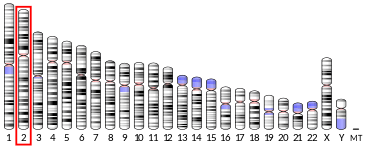WNT10A
Wnt-10a is a protein that in humans is encoded by the WNT10A gene.[4][5][6]
Function
The WNT gene family consists of structurally related genes which encode secreted signaling proteins. These proteins have been implicated in oncogenesis and in several developmental processes, including regulation of cell fate and patterning during embryogenesis. This gene is a member of the WNT gene family.[4]
Clinical significance
WNT10A is strongly expressed in the cell lines of promyelocytic leukemia and Burkitt's lymphoma. In addition, it and another family member, the WNT6 gene, are strongly coexpressed in colorectal cancer cell lines. The gene overexpression may play key roles in carcinogenesis through activation of the WNT-beta-catenin-TCF signaling pathway. This gene and the WNT6 gene are clustered in the chromosome 2q35 region.[4]
Mutations in the WNT10A gene are associated with Schöpf–Schulz–Passarge syndrome[7] and hypodontia.[8]
References
- GRCh38: Ensembl release 89: ENSG00000135925 - Ensembl, May 2017
- "Human PubMed Reference:". National Center for Biotechnology Information, U.S. National Library of Medicine.
- "Mouse PubMed Reference:". National Center for Biotechnology Information, U.S. National Library of Medicine.
- "Entrez Gene: wingless-type MMTV integration site family".
- Kirikoshi H, Sekihara H, Katoh M (May 2001). "WNT10A and WNT6, clustered in human chromosome 2q35 region with head-to-tail manner, are strongly coexpressed in SW480 cells". Biochem. Biophys. Res. Commun. 283 (4): 798–805. doi:10.1006/bbrc.2001.4855. PMID 11350055.
- Adaimy L, Chouery E, Megarbane H, Mroueh S, Delague V, Nicolas E, Belguith H, de Mazancourt P, Megarbane A (October 2007). "Mutation in WNT10A is associated with an autosomal recessive ectodermal dysplasia: the odonto-onycho-dermal dysplasia". Am. J. Hum. Genet. 81 (4): 821–8. doi:10.1086/520064. PMC 1973944. PMID 17847007.
- Bohring A, Stamm T, Spaich C, Haase C, Spree K, Hehr U, Hoffmann M, Ledig S, Sel S, Wieacker P, Röpke A (July 2009). "WNT10A mutations are a frequent cause of a broad spectrum of ectodermal dysplasias with sex-biased manifestation pattern in heterozygotes". Am. J. Hum. Genet. 85 (1): 97–105. doi:10.1016/j.ajhg.2009.06.001. PMC 2706962. PMID 19559398.
- van den Boogaard MJ, Créton M, Bronkhorst Y, van der Hout A, Hennekam E, Lindhout D, Cune M, Ploos van Amstel HK (May 2012). "Mutations in WNT10A are present in more than half of isolated hypodontia cases" (PDF). J. Med. Genet. 49 (5): 327–31. doi:10.1136/jmedgenet-2012-100750. PMID 22581971.
Further reading
- Gelebart P, Anand M, Armanious H, et al. (2008). "Constitutive activation of the Wnt canonical pathway in mantle cell lymphoma". Blood. 112 (13): 5171–9. doi:10.1182/blood-2008-02-139212. PMC 2597612. PMID 18787224.
- Beaty TH, Hetmanski JB, Fallin MD, et al. (2006). "Analysis of candidate genes on chromosome 2 in oral cleft case-parent trios from three populations". Hum. Genet. 120 (4): 501–18. doi:10.1007/s00439-006-0235-9. PMID 16953426.
- Nawaz S, Klar J, Wajid M, et al. (2009). "WNT10A missense mutation associated with a complete odonto-onycho-dermal dysplasia syndrome". Eur. J. Hum. Genet. 17 (12): 1600–5. doi:10.1038/ejhg.2009.81. PMC 2987016. PMID 19471313.
- Gerhard DS, Wagner L, Feingold EA, et al. (2004). "The status, quality, and expansion of the NIH full-length cDNA project: the Mammalian Gene Collection (MGC)". Genome Res. 14 (10B): 2121–7. doi:10.1101/gr.2596504. PMC 528928. PMID 15489334.
- Ota T, Suzuki Y, Nishikawa T, et al. (2004). "Complete sequencing and characterization of 21,243 full-length human cDNAs". Nat. Genet. 36 (1): 40–5. doi:10.1038/ng1285. PMID 14702039.
- Medland SE, Nyholt DR, Painter JN, et al. (2009). "Common variants in the trichohyalin gene are associated with straight hair in Europeans". Am. J. Hum. Genet. 85 (5): 750–5. doi:10.1016/j.ajhg.2009.10.009. PMC 2775823. PMID 19896111.
- Strausberg RL, Feingold EA, Grouse LH, et al. (2002). "Generation and initial analysis of more than 15,000 full-length human and mouse cDNA sequences". Proc. Natl. Acad. Sci. U.S.A. 99 (26): 16899–903. doi:10.1073/pnas.242603899. PMC 139241. PMID 12477932.
- Yerges LM, Klei L, Cauley JA, et al. (2009). "High-density association study of 383 candidate genes for volumetric BMD at the femoral neck and lumbar spine among older men". J. Bone Miner. Res. 24 (12): 2039–49. doi:10.1359/jbmr.090524. PMC 2791518. PMID 19453261.
- Memarian A, Hojjat-Farsangi M, Asgarian-Omran H, et al. (2009). "Variation in WNT genes expression in different subtypes of chronic lymphocytic leukemia". Leuk. Lymphoma. 50 (12): 2061–70. doi:10.3109/10428190903331082. PMID 19863181.
This article incorporates text from the United States National Library of Medicine, which is in the public domain.

